Footbridge
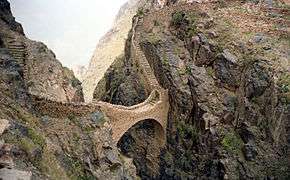
A footbridge (also called a pedestrian bridge, pedestrian overpass, or pedestrian overcrossing) is a bridge designed for pedestrians and in some cases cyclists, animal traffic, and horse riders, instead of vehicular traffic. Footbridges complement the landscape and can be used decoratively to visually link two distinct areas or to signal a transaction. In many developed countries, footbridges are both functional and can be beautiful works of art and sculpture. For poor rural communities in the developing world, a footbridge may be a community's only access to medical clinics, schools and markets, which would otherwise be unreachable when rivers are too high to cross. Simple suspension bridge designs have been developed to be sustainable and easily constructible in such rural areas using only local materials and labor.
An enclosed footbridge between two buildings is sometimes known as a skyway. Bridges providing for both pedestrians and cyclists are often referred to as greenbridges and form an important part of sustainable transport movement towards more sustainable cities. Footbridges are often situated to allow pedestrians to cross water or railways in areas where there are no nearby roads to necessitate a road bridge. They are also located across roads to let pedestrians cross safely without slowing down the traffic. The latter is a type of pedestrian separation structure, examples of which are particularly found near schools, to help prevent children running in front of moving cars.
Small footbridges can also be used for a technical effect in ornamental gardens.
Types footbridges include:
- Simple suspension bridge
- Clapper bridge
- Moon bridge
- Step-stone bridge
- Zig-zag bridge
- Plank
- Boardwalk
- Joisted
- Simple truss
The residential-scale footbridges all span a short distance and can be used for a broad range of applications. Complicated engineering is not needed and the footbridges are built with readily available materials and basic tools.[1]
Different types of design footbridges include:
Footbridges can also be built in the same ways as road or rail bridges; particularly suspension bridges and beam bridges. Some former road bridges have had their traffic diverted to alternative crossings and have become pedestrian bridges; examples in the UK include The Iron Bridge at Ironbridge, Shropshire, the Old Bridge at Pontypridd and Windsor Bridge at Windsor, Berkshire.
Most footbridges are equipped with guard rails to reduce the risk of pedestrians falling. Where they pass over busy roads or railways, they may also include a fence or other such barrier to prevent pedestrians from jumping, or throwing projectiles onto the traffic below.
Advantages
Provides safe and sustainable crossings and provides technical assistance to local government and communities need simple, easily applied guidelines on the selection and construction of effective water crossings. Much rural travel takes place on local paths, tracks and village roads. These provide essential access to water, firewood, farm plots and the classified road network. Communities and/or local government are generally responsible for this infrastructure.[2]
Disadvantages
Pedestrian overpasses over highways or railroads are expensive, especially when elevators or long ramps for wheelchair users are required. Without elevators or ramps, people with mobility handicaps will not be able to use the structure. Often, people will prefer to walk across a busy road at grade rather than expend the effort to climb up the bridge and go over it. Overpasses should only be used where the number of users justify the costs.[3]
Narrow, enclosed structures can result in perceptions of low personal security among users. Wider structures and good lighting can help reduce this.[4]
History
Footbridges are small, but important, because they are usually presented in townscape. The appearance of footbridges, and indeed of any other bridges, in a town, is a major concern for designers. People have to live with these structures, usually seeing them every day. In the towns that are big on architectural or scenic interest, conflicting demands may arise and bridges will be built.
Footbridges, in fact, can be elegant or beautiful, and are built on a more human scale than large road and railway bridges. Railway footbridges tend to be somewhat utilitarian, which were present in the earlier years. Apart from those in stations and in towns, they are generally not much seen, even by the passengers who go under them.[5]
In developing countries

Since the early 1980s, several charities have developed manualized footbridge designs that are sustainable for use in developing countries. The first charity to develop such standardized designs was Helvetas, located in Zurich, Switzerland.[6] Designs that can be sustainably and efficiently used in developing countries are typically made available to the public gratis. The number of bridges built using such wire rope technology in developing countries number over 6,000 (versus a worldwide need of 500,000.
Examples
The record for the longest footbridge in the world is claimed by the Poughkeepsie Bridge across the Hudson River at Poughkeepsie, New York.[7] Originally built for trains, it was recently restored as a pedestrian walkway. The footbridge has a total length of 2,063 meters (6,768 feet). Before it was demolished in 2011, the Hornibrook Bridge which crossed Bramble Bay in Queensland, Australia was longer than the Poughkeepsie Bridge at 2.8 km (1.7 mi).[8] Other examples include:
- The Bank Bridge and the Bridge of Four Lions in Saint Petersburg
- The Big Dam Bridge in Little Rock, Arkansas
- The Capilano Suspension Bridge in British Columbia
- The Chain of Rocks Bridge near St. Louis, Missouri
- The Davenport Skybridge in Davenport, Iowa
- The Dunlop Bridge in Circuit de la Sarthe, Le Mans, Sarthe
- The Esplanade Riel in Winnipeg, Manitoba
- The Gateshead Millennium Bridge
- The Goodwill Bridge at Brisbane, Australia
- The Ha'penny Bridge in Dublin, Ireland
- The Bob Kerrey Pedestrian Bridge, Omaha, Nebraska
- The Jade Belt Bridge in the Summer Palace in Beijing
- The Kingsgate Bridge in Durham, England
- The Liberty Bridge at Falls Park on the Reedy in Greenville, South Carolina
- The Millennium Bridge and the high-level walkways in Tower Bridge in London
- The Newport Southbank Bridge between Newport, Kentucky and Cincinnati
- The Pont des Arts in Paris
- The Ponte Milvio in Rome
- The Ponte Sant'Angelo in Rome
- The Pushkinsky and Bogdan Khmelnitsky Pedestrian bridges in Moscow
- The Corktown Footbridge in Ottawa
- The Rolling Bridge at Paddington Basin, London
- The Southbank footbridge in Southbank, Victoria
- The Shelby Street Bridge in Nashville, Tennessee
- The Tournament Bridge
- The pedestrian walkway over the Tropicana – Las Vegas Boulevard intersection in Paradise, Nevada
- The Waco Suspension Bridge in Waco, Texas
- The Webb bridge in Melbourne Docklands
- The Walnut Street Bridges in Harrisburg, Pennsylvania and Chattanooga, Tennessee
- The Willimantic Footbridge in Willimantic, Connecticut
Railways
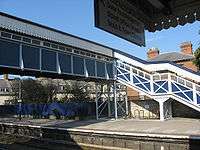
It was originally usual for passengers to cross from one railway platform to another by stepping over the tracks, but from the mid-19th century onwards safety demanded the provision of a footbridge (or underpass) at busier places. However, in some quieter areas, crossing the line by walking over the tracks is possible.
Design
Design of footbridges normally follows the same principles as for other bridges. However, because they are normally significantly lighter than vehicular bridges, they are more vulnerable to vibration and therefore dynamics effects are often given more attention in design.[9] International attention has been drawn to this issue in recent years by problems on the Pont de Solférino in Paris and the Millennium Bridge in London.
To ensure footbridges are accessible to disabled and other mobility-impaired people, careful consideration is also given to provision of access lifts or ramps, as required by relevant legislation (e.g. Disability Discrimination Act 1995 in the UK).[9] Some old bridges in Venice are now equipped with a stairlift so that residents with a disability can cross them.
Catwalk
Narrow footbridges or walkways to allow workers access to parts of a structure otherwise difficult to reach are referred as catwalks or cat walks.[10] Such catwalks are located above a stage (theater catwalk) in a theater, between parts of a building, along the side of a bridge, on the inside of a tunnel, on the outside of any large storage tank in a refinery or elsewhere, etc. The walkway on the outside (top) of a railroad cars such as boxcars, before air brakes came into use, or on top of some covered hopper cars is also called a catwalk.[11] With the exception of those on top of railroad cars, catwalks are equipped with railings or handrails.
Gallery
- A stressed ribbon bridge for pedestrians, bicycles, and pipelines in Grants Pass, Oregon
 Melbourne's Sandridge Bridge which overpasses the Yarra River
Melbourne's Sandridge Bridge which overpasses the Yarra River
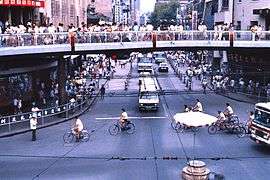 A pedestrian overcross in Nanjing Road, Shanghai
A pedestrian overcross in Nanjing Road, Shanghai_river_at_Suruga_in_Shizuoka_Prefecture_in_Japan_-_circa_1890.tif.jpg) A footbridge over the Fujikawa (Fuji) river at Suruga in Shizuoka Prefecture in Japan
A footbridge over the Fujikawa (Fuji) river at Suruga in Shizuoka Prefecture in Japan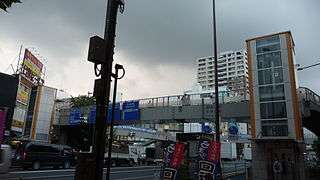 A footbridge with four elevators on each corner of a four-way intersection in Tokyo
A footbridge with four elevators on each corner of a four-way intersection in Tokyo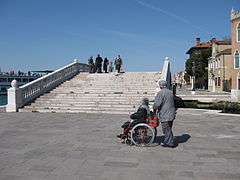 A footbridge over a canal in Venice
A footbridge over a canal in Venice- A footbridge for hikers in Washington State's Mount Baker-Snoqualmie National Forest, USA.
See also
References
- ↑ Jeswald, P. (2005). How to build paths, steps & Footbridges. North Adams, Massachusetts: Storey Publishing.
- ↑ Dennis, R. (2004). "Foot Bridges". Retrieved June 25, 2010 Archived July 15, 2007, at the Wayback Machine.
- ↑ "Pedestrian Overpasses/Underpasses". Pedestrian Bicycle Information Center. Retrieved 2013-11-14.
- ↑ Rory Renfro (June 2007). "Pedestrian/Bicycle Overcrossings: Lessons Learned" (PDF).
- ↑ http://www.brantacan.co.uk/index.htm.
- ↑ Archived May 3, 2012, at the Wayback Machine.
- ↑ "WALKWAY OPENS, THOUSANDS EXPLORE UNIQUE STATE PARK". Poughkeepsie Journal. Poughkeepsie, New York. October 3, 2009. Archived from the original on April 2, 2015. Retrieved 2009-10-06.
- ↑ Final Curtain for the Hornibrook Highway
- 1 2 Schlaich, Mike, et al., Guidelines for the Design of Footbridges, International Federation for Structural Concrete, 2005, ISBN 2-88394-072-X
- ↑ "Negligence Petroleum storage tank exploded" (PDF). July 2000.
- ↑ "catwalk". webster-dictionary.net. Retrieved 10 April 2015.
External links
| Wikimedia Commons has media related to Footbridges. |
| Look up catwalk in Wiktionary, the free dictionary. |